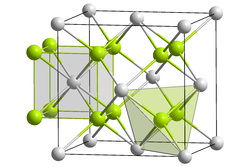Titanium dihydride
| Crystal structure | |||||||||||||||||||
|---|---|---|---|---|---|---|---|---|---|---|---|---|---|---|---|---|---|---|---|

|
|||||||||||||||||||
| __ Ti 2+ __ H - | |||||||||||||||||||
| General | |||||||||||||||||||
| Surname | Titanium dihydride | ||||||||||||||||||
| other names |
Titanium (II) hydride |
||||||||||||||||||
| Ratio formula | TiH 2 | ||||||||||||||||||
| Brief description |
cubic crystals with a metallic appearance |
||||||||||||||||||
| External identifiers / databases | |||||||||||||||||||
|
|||||||||||||||||||
| properties | |||||||||||||||||||
| Molar mass | 49.90 g mol −1 | ||||||||||||||||||
| Physical state |
firmly |
||||||||||||||||||
| density |
3.76 g cm −3 |
||||||||||||||||||
| Melting point |
600 ° C (decomposition) |
||||||||||||||||||
| solubility |
Decomposes in water |
||||||||||||||||||
| safety instructions | |||||||||||||||||||
|
|||||||||||||||||||
| As far as possible and customary, SI units are used. Unless otherwise noted, the data given apply to standard conditions . | |||||||||||||||||||
Titanium dihydride is a chemical compound of titanium and hydrogen .
Extraction and presentation
Titanium dihydride can be obtained by hydrogenating titanium with hydrogen, whereby the reaction begins at 300 ° C and proceeds rapidly from 400 ° C. Partially hydrogenated titanium reacts with the most carefully purified hydrogen already at 20 ° C. Depending on the degree of conversion, the compound has a stoichiometric ratio of up to TiH 1.998 . By heating to temperatures above 400 ° C in a high vacuum, hydrogen is released again in the case of highly hydrogenated products. At 1000 ° C, the hydrogen is completely released.
properties
Titanium dihydride is a powder with a metallic sheen in its pure form. Otherwise it is light gray and may have a surface tinted blue or yellow due to traces of oxygen or nitrogen. The crystal structure differs depending on the degree of conversion. Up to TiH 0.5 , the hydrogen simply dissolves in the metal lattice. TiH 2 has a defect calcium fluoride type crystal structure .
use
Titanium dihydride is used as a blowing agent in the production of metal foams . It is mixed with metal powder and the mixture is then heated to almost the melting point of the metal . The titanium dihydride releases hydrogen bubbles, which creates metal foam . It is interesting that titanium dihydride, due to its high density, stores twice as much hydrogen in the same volume as liquid hydrogen.
Individual evidence
- ↑ Entry on titanium hydride. In: Römpp Online . Georg Thieme Verlag, accessed April 1, 2014.
- ↑ a b c data sheet titanium hydride (PDF) from Merck , accessed on April 24, 2011.
- ↑ a b data sheet titanium dihydride from AlfaAesar, accessed on February 7, 2010 ( PDF )(JavaScript required) . .
- ↑ a b Georg Brauer (Ed.), With the collaboration of Marianne Baudler u a .: Handbook of Preparative Inorganic Chemistry. 3rd, revised edition. Volume II, Ferdinand Enke, Stuttgart 1978, ISBN 3-432-87813-3 , p. 1333.
